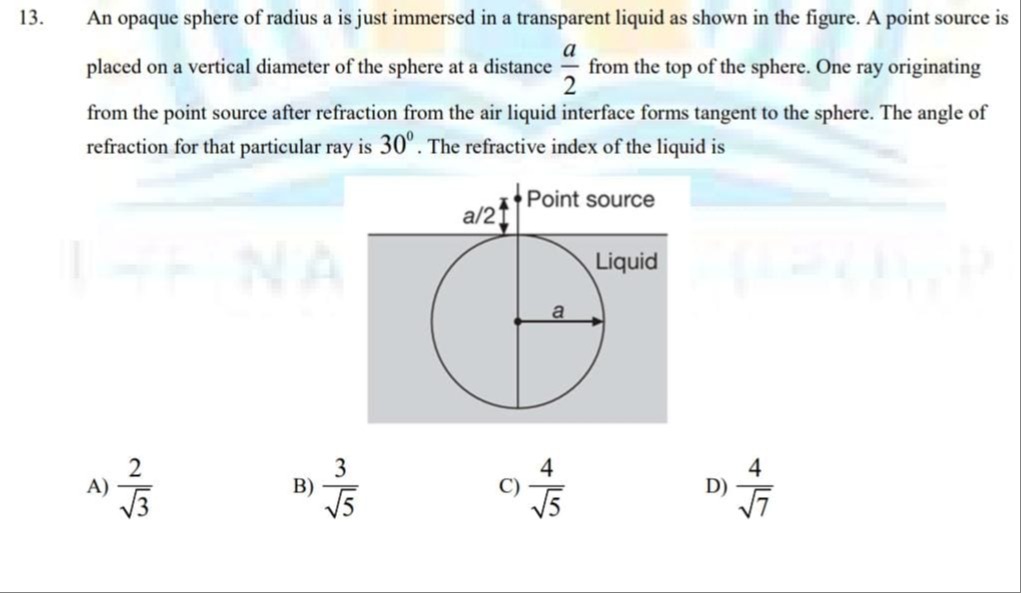Question
Question: An opaque sphere of radius a is just immersed in a transparent liquid as shown in the figure. A poin...
An opaque sphere of radius a is just immersed in a transparent liquid as shown in the figure. A point source is placed on a vertical diameter of the sphere at a distance 2a from the top of the sphere. One ray originating from the point source after refraction from the air liquid interface forms tangent to the sphere. The angle of refraction for that particular ray is 30∘. The refractive index of the liquid is

32
53
54
74
74
Solution
We set up the problem by choosing a coordinate system so that the horizontal liquid–air interface is at y=0. “Just immersed” means that the sphere touches the interface at its top. Choosing
Top T=(0,0),Center C=(0,a),Radius =a,the sphere is described by
x2+(y−a)2=a2.The point source is said to lie on a vertical line through the sphere, at a distance 2a from the top. (It is more natural here to assume that the source is above the interface so that its light enters the liquid.) Thus, with the positive y–axis directed downward, we take the source as
S=(0,−a/2).A ray from S meets the interface at R=(xR,0). In air (with refractive index 1), the ray makes an incident angle
sini=xR2+(a/2)2∣xR∣.After refraction at R into the liquid (of refractive index n) the ray makes an angle r=30∘ with the vertical (normal to the interface). Snell’s law gives
sini=nsin30∘=2n.Thus,
xR2+(a/2)2∣xR∣=2n.Squaring both sides we obtain
xR2+a2/4xR2=4n2⟹(4−n2)xR2=4n2a2.Therefore,
xR2=4(4−n2)n2a2.(A)Now, the ray (in the liquid) emerging from R has direction making 30∘ with the vertical. Choosing (without loss of generality) the positive x–direction we have the direction vector
d^=(sin30∘,cos30∘)=(0.5,3/2).Thus the ray in the liquid is given by
r(t)=(xR+0.5t,0+(3/2)t).Let the ray touch the sphere at the tangent point Q. At tangency, the radius drawn to Q is perpendicular to the ray’s direction. With Q=(xR+0.5t0,(3/2)t0) and C=(0,a), the tangency condition is:
[(xR+0.5t0)−0,(3/2t0)−a]⋅(0.5,3/2)=0.Calculating the dot product:
0.5(xR+0.5t0)+23(23t0−a)=0.Note that 23⋅23=43. Hence,
0.5xR+0.25t0+0.75t0−23a=0⟹0.5xR+t0−23a=0,so that
t0=23a−0.5xR.(1)Since Q lies on the sphere, it must satisfy
[xR+0.5t0]2+[23t0−a]2=a2.(2)Substitute t0 from (1):
0.5t0=0.5(23a−0.5xR)=43a−0.25xR,and
23t0=23(23a−0.5xR)=43a−43xR.Thus, the coordinates of Q become:
xQ=xR+43a−0.25xR=0.75xR+43a, yQ=43a−43xR.Plugging these in the sphere equation (2):
(0.75xR+43a)2+[(43a−43xR)−a]2=a2.Notice that
(43a−43xR−a)=−41a−43xR.Expanding both squares (and using exact values 0.75=43 and 43):
(43xR+43a)2+(41a+43xR)2=a2.Expanding,
169xR2+162⋅33axR+163a2+161a2+1623axR+163xR2=a2.Combine like terms:
- Coefficient of xR2: 169+163=1612=43.
- Coefficient of axR: 1663+1623=1683=23.
- Coefficient of a2: 163+161=41.
Thus the equation reduces to:
43xR2+23axR+41a2=a2.Multiply through by 4 to clear denominators:
3xR2+23axR+a2=4a2,or
3xR2+23axR−3a2=0.Dividing by 3:
xR2+323axR−a2=0.(3)Solve (3) using the quadratic formula:
xR=2−323a±(323a)2+4a2.Compute the discriminant:
(323a)2+4a2=94⋅3a2+4a2=34a2+4a2=316a2.Thus,
xR=2−323a±34a.Taking the positive root (since xR is taken as positive),
xR=2−323a+34a=2(3−23+43)a=2323a=3a3.Now equate this result with our earlier relation (A):
3a2=4(4−n2)n2a2.Cancel a2 (with a=0) and cross–multiply:
4(4−n2)=3n2.That is,
16−4n2=3n2⟹16=7n2,so that,
n2=716⟹n=74.Thus, the refractive index of the liquid is 74 which is option D.
Summary of the solution:
-
Coordinate Setup:
- Interface at y=0, sphere with center (0,a) and radius a; top touches (0,0).
- Point source taken at S=(0,−a/2) (on the vertical through the sphere).
-
For the ray coming from S and refracting at R=(xR,0):
- By Snell’s law: xR2+(a/2)2∣xR∣=2n.
- This gives xR2=4(4−n2)n2a2.
-
Tangent Condition to the Sphere:
- The ray (with direction (0.5,3/2)) touches the sphere tangentially, producing a second equation which on solution gives xR=3a3.
-
Combining the two results yields:
n=74.
Final Answer: 74 (option D).
Subject: NCERT Physics – Optics
Chapter: Ray Optics
Topic: Refraction of Light
